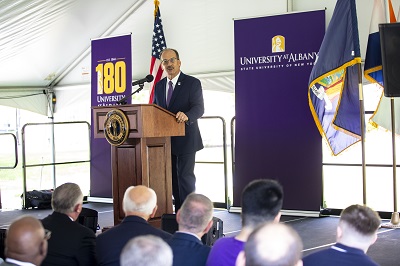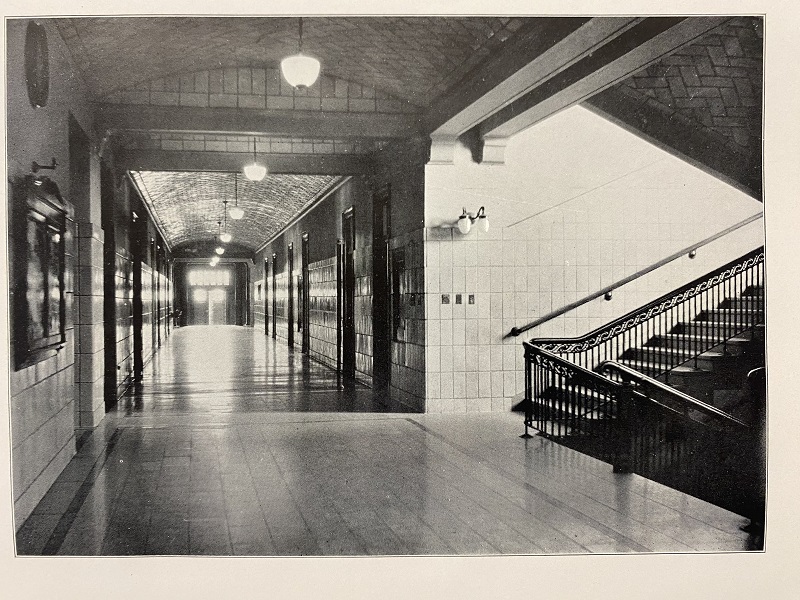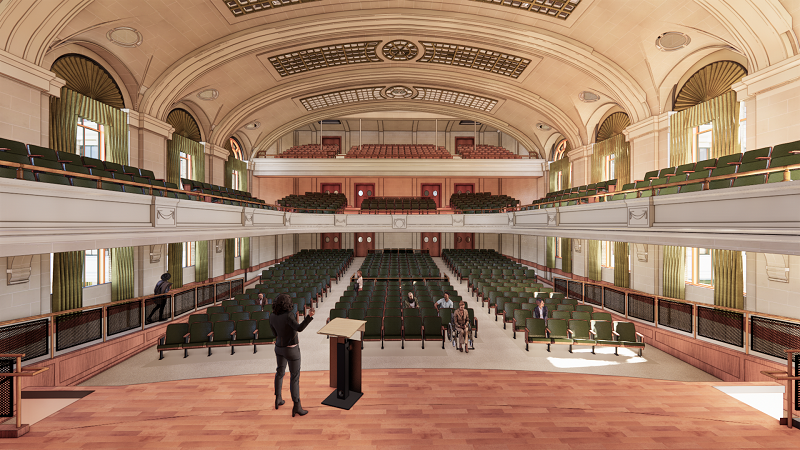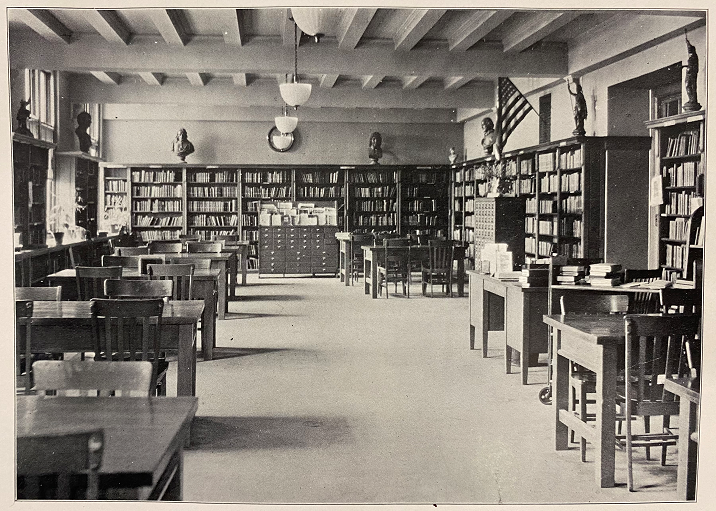UAlbany Unveils New CNSE Building in Renovated Former Albany High School
ALBANY, N.Y. (May 21, 2024) — The University at Albany on Tuesday unveiled the new home of its College of Nanotechnology, Science, and Engineering Tuesday morning in the renovated former Albany High School, UAlbany’s most significant expansion in midtown since the Downtown Campus was completed in 1929.
The college’s Department of Electrical & Computer Engineering began moving into the renovated south wing last week, following the dean’s office in February, marking the halfway point of the transformational project and the return of students and educators to the 112-year-old building for the first time in more than a decade.
“This building is a physical manifestation of UAlbany’s steadfast commitment to Albany and our optimism for our region’s high-tech future,” said UAlbany President Havidán Rodríguez. “UAlbany has called this block home for more than a century. Today, as we mark our 180th anniversary we are bringing some of our most in-demand, research-intensive programs to the heart of the city. Careers in engineering and computer science should be an option for everyone — and sometimes seeing is believing. We are so grateful to our elected representatives and other partners in the city and the state who helped make real our dream of giving our engineering college a state-of-the-art home that pays homage to our city’s history.”

The renovated south wing includes four floors of modern classrooms, research labs, offices and hands-on engineering spaces thoughtfully interwoven into the building’s century-old architectural fabric.
“We would not be standing here today without those who doggedly fought for this project because they refused to accept that Capital Region students didn’t deserve a high-quality public engineering option,” Rodríguez said. “Gov. Hochul, Sen. Neil Breslin and assemblymembers Pat Fahy and John McDonald understood that building an engineering college at one of the most diverse public research institutions in the country wasn’t about prestige. It’s about cultivating the diverse STEM workforce we need to ensure that new technologies like AI are developed in ways that are trustworthy and equitable to all New Yorkers.”
SUNY Chancellor John B. King Jr. said, “This incredibly exciting, eagerly awaited project has been years in the making, and could not have happened without the intense support of Gov. Kathy Hochul, Sen. Neil Breslin and assemblymembers Pat Fahy and John McDonald. Now, as its doors open, the University at Albany can expand its research capacity and increase opportunities for students to gain hands-on experience in a space dedicated to the College of Nanotechnology, Science, and Engineering. The state-of-the-art facility will be a true asset to the Capital Region and the state as New York leads as a research and development hub for industries like semiconductor manufacturing and artificial intelligence, while growing a much-needed diverse STEM workforce.”
New Space for New Programs
The block-long Neo-Classical building on North Lake Avenue is a longstanding midtown educational landmark. Serving as Albany High School from 1913 to 1974, it stood for 100 years as the only building on Western Avenue between Robin Street and North Lake not already part of UAlbany’s Downtown Campus, which opened three years earlier in 1909.
After the high school moved further up Washington Avenue in 1974, the building housed Philip Schuyler Elementary School and other educational programs. UAlbany purchased it from the City School District of Albany in 2013 and in 2016 announced it would become the new home of what is now the College of Nanotechnology, Science, and Engineering — or CNSE. UAlbany’s engineering programs were built upon its longstanding strength in computer science, which dates to the University’s first Computing Center in the 1960s, and their addition beginning in 2015 was part of the University’s largest academic expansion in 50 years.
College-wide, CNSE has grown to nearly 1,500 undergraduate majors, intended majors and graduate students — up 32 percent between 2019 to 2023. That increase does not include the addition of Department of Nanoscale Science & Engineering students who returned to UAlbany, along with nine nanotechnology-related academic programs, from SUNY Polytechnic Institute last fall.
CNSE research expenditures are expected to surpass $17 million this fiscal year.
CNSE Dean Michele J. Grimm said, “Our new CNSE Downtown facility is evidence of UAlbany, SUNY and New York State’s commitment to ensuring an excellent engineering education is accessible to everyone and that we are fully harnessing our public universities as hubs for community development and technological advancement that drives economic growth. Each step within this building showcases our dedication to honoring the past even as our students and faculty reach to expand the frontiers of computer science and engineering. CNSE’s Albany footprint now stretches from the Downtown Campus to ETEC to Albany NanoTech, which is fitting as we look for new opportunities to connect the community with our growing portfolio of unique educational programs.”
CNSE students will use the building for the first time this fall. Inside, they will find teaching and research spaces built specifically for engineering and computational applications.
The building’s most striking transformation is a new 4,800 square-foot Maker/Tinker Space in the former basement gymnasium that will now be used for prototype development and testing and includes 3D printers, a 700-square-foot machine shop, and facilities for electronics design and fabrication.
The south wing renovation spans 62,600 square feet — about half the building’s total 129,000 square feet. The approximately $85 million project was broken up into phases, and construction will now shift to the north wing and auditorium.
The most visible exterior changes are more than 430 new, architecturally appropriate and energy efficient windows and the shortening of the grand staircase facing Western Avenue, the building’s former main entrance. A new entry plaza and two-story lobby has been added on the east side of the building facing the rest of the Downtown Campus. Visitors will now enter through what was formerly the boys’ locker room. The new entrance connects the building to the rest of the Downtown Campus, provides greater accessibility and links directly to CDTA’s new Purple Line BRT station.
Preserving a Midtown Albany Landmark

While some spaces inside the building are unrecognizable from their past, others — including the distinctive Guastavino tile ceilings in the first-floor central corridor — look much the way they did when the building was first constructed.
Working with the State Historic Preservation Office, the State University Construction Fund (SUCF) and project architect CSArch, UAlbany identified character-defining spaces where no alterations were made, existing finishes were preserved, and the visible effects of essential mechanical and life-safety upgrades were minimized. New equipment, light fixtures and signage were designed to respect the original building fabric. Outside these zones, historic elements were preserved as much as possible.
Consigli Construction Co. is the prime contractor on the project, and Gilbane Building Company is the construction manager.
In 2022, UAlbany received a $75 million appropriation from the state — about half of which would fund the final phases of the engineering building’s renovation. The other half is supporting UAlbany’s AI Plus initiative, in which CNSE plays a critical academic and research role.
Sen. Neil D. Breslin said, “I am proud to see several years of planning and hard work come to fruition with the opening of a new home for UAlbany’s College of Nanotechnology, Science, and Engineering on the Downtown Campus. This cutting-edge facility will serve as the site of UAlbany’s mission to provide affordable, world-class instruction to the next generation of engineers and tech leaders in our state. The integration of UAlbany’s engineering school into the city’s urban core will surely add to the vibrancy of the neighborhood around Washington Park, and I look forward to watching the downtown campus community grow and thrive in the coming years.”
Assemblymember Patricia Fahy said, “The revitalized former Albany High School is finally opening, marking a milestone in our Capital City and Region. I was proud to have secured $75 million for this transformation in previous state budgets alongside the Capital Region delegation, and am thrilled to see it open as the new College of Nanotechnology, Science, and Engineering, continuing to pave our way forward on AI, semiconductor engineering, climate change prediction, and so much more. UAlbany is a cornerstone of Albany, and I couldn’t be more thrilled to see this new section of the Downtown Campus open its doors thanks to the work of so many, including President Havidán Rodríguez.”
Assemblymember John T. McDonald III said, "Congratulations to the University at Albany on the long-awaited opening of the new College of Nanotechnology, Science, and Engineering building. Through the programs in this building and its AI Plus initiative, UAlbany will be an innovator in cutting edge technologies that not only benefit industry as a whole but also boost the Capital Region. I proudly worked with Assemblymember Fahy and Senator Breslin to secure funding toward this effort and thank all of the partners who are going to be a part of this exciting effort."
Albany Mayor Kathy Sheehan said, "UAlbany's new CNSE space is a state-of-the-art addition to our flagship SUNY campus and is yet another example of the ways we are attracting the best and brightest to the City of Albany and the Capital Region. This new CNSE space also brings with it a historic transformation to a building that means so much to the Pine Hills neighborhood: the former Albany High School. I commend the leadership of Gov. Hochul, Chancellor King, Senator Breslin, Assemblymember Fahy, and Assemblymember McDonald for securing the necessary funding to make this expansion possible. I also want to share a heartfelt thanks to President Rodríguez and the UAlbany leadership past and present whose tireless vision is now reality."
Empire State Development, at the recommendation of the Capital Region Economic Development Council, contributed $2.5 million toward the project in support of the strategic goals of growing the Capital Region’s research footprint in economically important sectors like semiconductor development and AI and building a pipeline for the highly educated and diverse workforce that tech companies need.
Empire State Development President, CEO and Commissioner Hope Knight said, “As New York continues to focus on growing cutting-edge industries of the future, the College of Nanotechnology, Science, and Engineering is key to our success. CNSE will bolster our workforce pipeline for the growing list of companies choosing to locate and expand in New York State such as Micron, GlobalFoundries and Wolfspeed, and it will help jumpstart neighborhood and community revitalization with an influx of students, faculty and researchers.”
Some CNSE teaching and research will remain at other locations with specialized facilities, including the Albany NanoTech Complex.
Next: The North Wing & Auditorium

The final phase of the CNSE Downtown project includes a comparable renovation and restoration of the building’s north wing (approximately 55,000 square feet) into additional research, teaching and office spaces for CNSE’s Department of Computer Science.
It also includes refurbishing the building’s grand central staircase off North Lake Avenue and the renovation and restoration of the stunning, 11,000-square-foot auditorium into a modern event space with about 760 seats on three levels. Once complete, the auditorium will be among the largest and most grand on campus.
This final phase of the project is expected to be complete in mid-2027.














